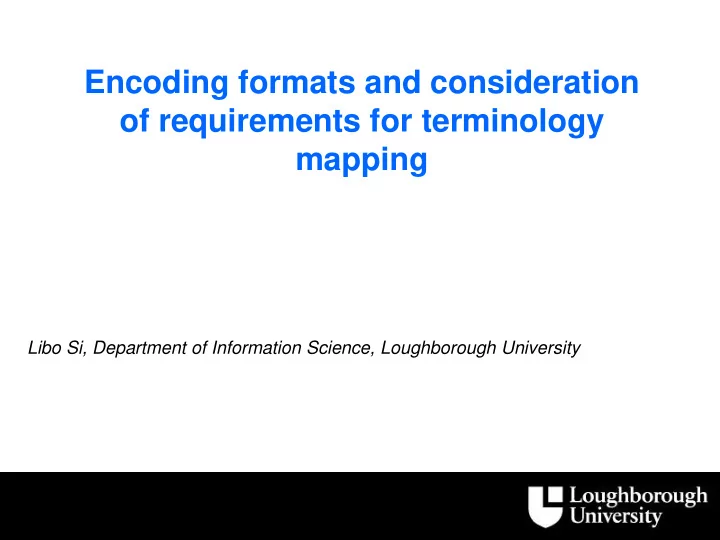

Encoding formats and consideration of requirements for terminology mapping Libo Si, Department of Information Science, Loughborough University
Structure of this presentation Introduction to KOS mapping methods developed; Introduction to four encoding formats; Two frameworks to improve interoperability between different encoding formats;
Interoperability
Mapping to bridge the semantic gaps between different systems? “the process of associating elements of one set with elements of another set, or the set of associations that come out of such a process”. (www.semantic world.org)
Establishing semantic mapping between KOS [1] Zeng, Marcia Lei and Lois Mai Chan. 2004. Trends and issues in establishing interoperability among knowledge organization systems; [2] BS8723-Part 4; [3] Patel, Manjula, Koch, Traugott, Doerr, Martin and Tsinaraki, Chrisa (2005). Semantic Interoperability in Digital Library Systems. [4] Tudhope, D., Koch, T. and Heery, R. (2006). Terminology Services and Technology.
Mappings between KOS in the semantic level Derivation; Direct mapping; Switch language; Co-occurrence mapping; Satellite and leaf node linking; Merging; Linking through a temporary union list; Linking through a thesaurus server protocol.
Factors to challenge KOS interoperability in different levels Levels of interoperability Factors of interoperability Different subject areas Different degree of pre- Scheme level coordination/post-coordination Different granularity Different languages Different encoding formats Record level Different metadata schemes to describe KOS System level Different protocols to access KOS Different IR systems
Knowledge representation formats MARC21 for authority files; Zthes XML DTD/Schema; XML Topic Map for representing controlled vocabularies: Techquila's Published Subject Identifiers for a thesaurus ontology; Techquila's Published Subject Identifiers for a classification system ontology; Techquila's Published Subject Identifiers for a faceted classification system; Techquila's Published Subject Identifiers for modelling hierarchical relationships; SKOS: SKOS-Core, SKOS-Mapping, and SKOS- extension.
MARC 21 for authority file <record> <leader>…</leader> <controlfield tag=“001”>GSAFD000002</controlfield> <controlfield tag=“003”>IlchALCS</controlfield> <controlfield tag=“005”>20000724203806.0</controlfield> <datafield tag=“040” ind1=“” ind2=“”> <subfield code=“a”>IlchaALCS</subfield> <subfield code=“b”>eng</subfield> <subfield code=“c”>IEN</subfield> Preferred term <subfield code=“f”>gsafd</subfield> </datafield> <datafield tag=“155”> <subfield code=“a”>Adventure film</subfield> </datafield> <datafield tag=“455”> <subfield code=“a”>Swashbucklers</subfield></datafield> Nonpreferred term <datafield tag=“455”> <subfield code=“a”>Thrillers</subfield> </datafield> <datafield tag=“555”> <subfield code=“w”>h</subfield><subfield code=“a”>spy films</subfield></datafield> <datafield tag=“555”> <subfield code=“w”>h</subfield><subfield code=“a”>spy television programs</subfield></datafield> Narrower term <datafield tag=“555”> <subfield code=“w”>h</subfield><subfield code=“a”>western films</subfield></datafield> <datafield tag=“555”> <subfield code=“w”>h</subfield><subfield code=“a”>western televsion programs</subfield></datafield> <datafield tag=“555”> <subfield code=“a”>sea film</subfield></datafield> </record> Related term
Zthes XML Schema — term-based <?xml version="1.0" encoding="utf-8" ?> <Zthes> <term> <termId> 1 </termId> <termName> Brachiosauridae </termName> <termType> PT </termType> <termNote> Defined by Wilson and Sereno (1998) as the clade of all organisms more closely related to _Brachiosaurus_ than to _Saltasaurus_. </termNote> <postings> <sourceDb> z39.50s://example.zthes.z3950.org:3950/dino </sourceDb> <fieldName> title </fieldName> <hitCount> 23 </hitCount> </postings> <relation> <relationType> BT </relationType> <termId> 2 </termId> <termName> Titanosauriformes </termName> <termType> PT </termType> </relation> <relation> <relationType> NT </relationType> <termId> 3 </termId> <termName> Brachiosaurus </termName> <termType> PT </termType> </relation> </term> </Zthes>
XTM for representing KOS <topic id=”0001”> <topic id=”0012”> <xtm:instanceOf> <xtm:subjectIndicatorRef <xtm:instanceOf> xlink:href=" http://www.techquila.com/psi/thes <xtm:subjectIndicatorRef aurus/#concept " /> xlink:href=" http://www.techquila.com/psi/thes </xtm:instanceOf> aurus/#concept " /> <subjectIdentity> </xtm:instanceOf> <resourceRef <subjectIdentity> xlink:href=http://www.zoologypark.org/animals.xt <resourceRef m#cats /> xlink:href=http://www.zoologypark.org/animals.xt </subjectIdentity> m#mammals /> <baseName> </subjectIdentity> <baseNameString>cats</baseNameString> <baseName> <variant> <baseNameString>mammals</baseNameString> <variantName> </baseName> <resourceData>felines</resourceData> </topic> </variantName> </variant> </baseName> </topic> http://www.techquila.com/psi/
XTM for representing KOS < association> <instanceOf> <subjectIndicatorRef xlink:href=" http://www.techquila.com/psi/thesaurus/thesaurus.xtm #broader-narrower"/> </instanceOf> <member> <roleSpec> <subjectIndicatorRef xlink:href=" http://www.techquila.com/psi/thesaurus/thesaurus.xtm #broader"/> </roleSpec> <topicRef xlink:href="#0012"/> </member> <member> <roleSpec> <subjectIndicatorRef xlink:href=" http://www.techquila.com/psi/thesaurus/thesaurus.xtm #narrower "/> </roleSpec> <topicRef xlink:href="#0001"/> </member> </association>
SKOS <rdf:RDF xmlns:rdf="http://www.w3.org/1999/02/22-rdf-syntax-ns#" xmlns:rdfs="http://www.w3.org/2000/01/rdf-schema#" xmlns:skos="http://www.w3.org/2004/02/skos/core#"> <skos:Concept rdf:about= "http://www.socialsciencepark.org/thesaurus/concept/a092"> <skos:prefLabel>freedom</skos:prefLabel> <skos:altLabel>liberty </skos:altLabel> <skos:scopeNote>the rights to control one’s own right</skos:scopeNote> <skos:broader rdf:resource=”http://www.socialsciencepark.org/thesaurus/concept/a045"/> <skos:narrower rdf:resource="http://www.socialsciencepark.org/thesaurus/concept/a0945"/> <skos:narrower rdf:resource= "http://www.socialsciencepark.org/thesaurus/concept/a0946"/> <skos:narrower rdf:resource= "http://www.socialsciencepark.org/thesaurus/concept/a097"/> <skos:related rdf:resource= "http://www.socialsciencepark.org/thesaurus/concept/b056"/> <skos:inScheme rdf:resource= “http://www.socialsciencepark.org/thesaurus”/> </skos:Concept> </rdf:RDF>
MARC21 for Zthes XML XTM SKOS AF Schema Specificity Cannot No support on Can represent various Can represent represent some faceted complicated KOS various complex classifications complicated relationships, KOS, but lack of e.g. part-whole, power of etc. validating the RDF data Ontological Cannot be Cannot be Can be extended to a Can be extended extensibility extended to an extended to topic map ontology. to an OWL ontology an ontology ontology Term-based or Concept-based Term-based Both concept-based Concept-based concept-based and term-based Tools, XSLT-related XSLT-based XTM APIs, such as, RDF-APIs, protocols or technologies, technologies TMQL, SKOS-APIs, and APIs to MARC SPARQL access systems. protocol Capability of Cannot encode No mapping Can be extended to SKOS-mapping supporting very specific capability support mapping mapping mapping relationships
Issues (1) 1. XML-based formats are limited and cannot represent some of the more complex thesauri or ontologies and the mappings between them, and therefore RDF-based or XTM-based formats are more appropriate to be extended to encode ontological vocabularies; 2. It is impractical to use only one representation format to encode all the controlled vocabularies, because each has its own structures and syntax. More importantly, different representation formats can be converted into each other depending on the specific requirements.
Recommend
More recommend